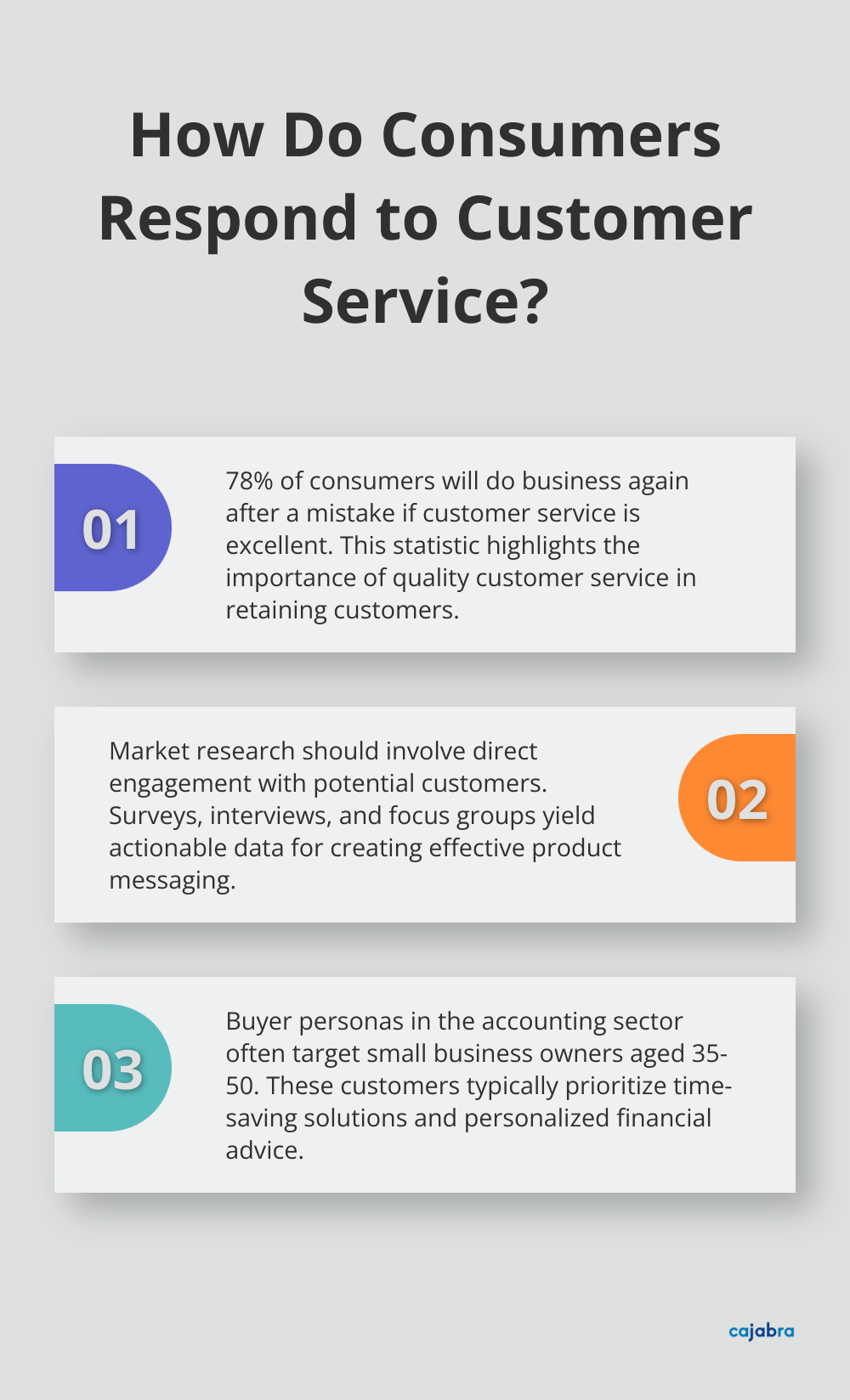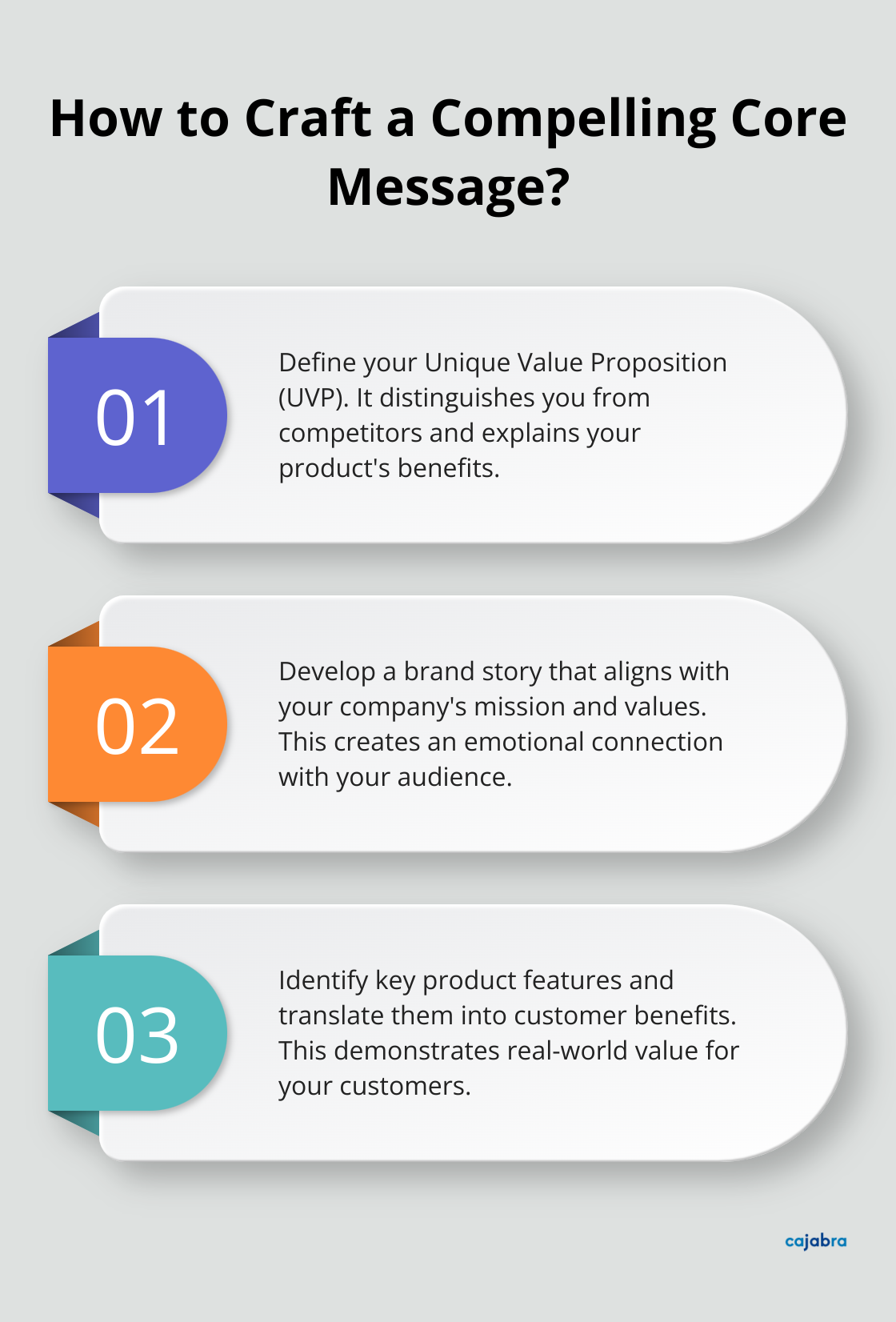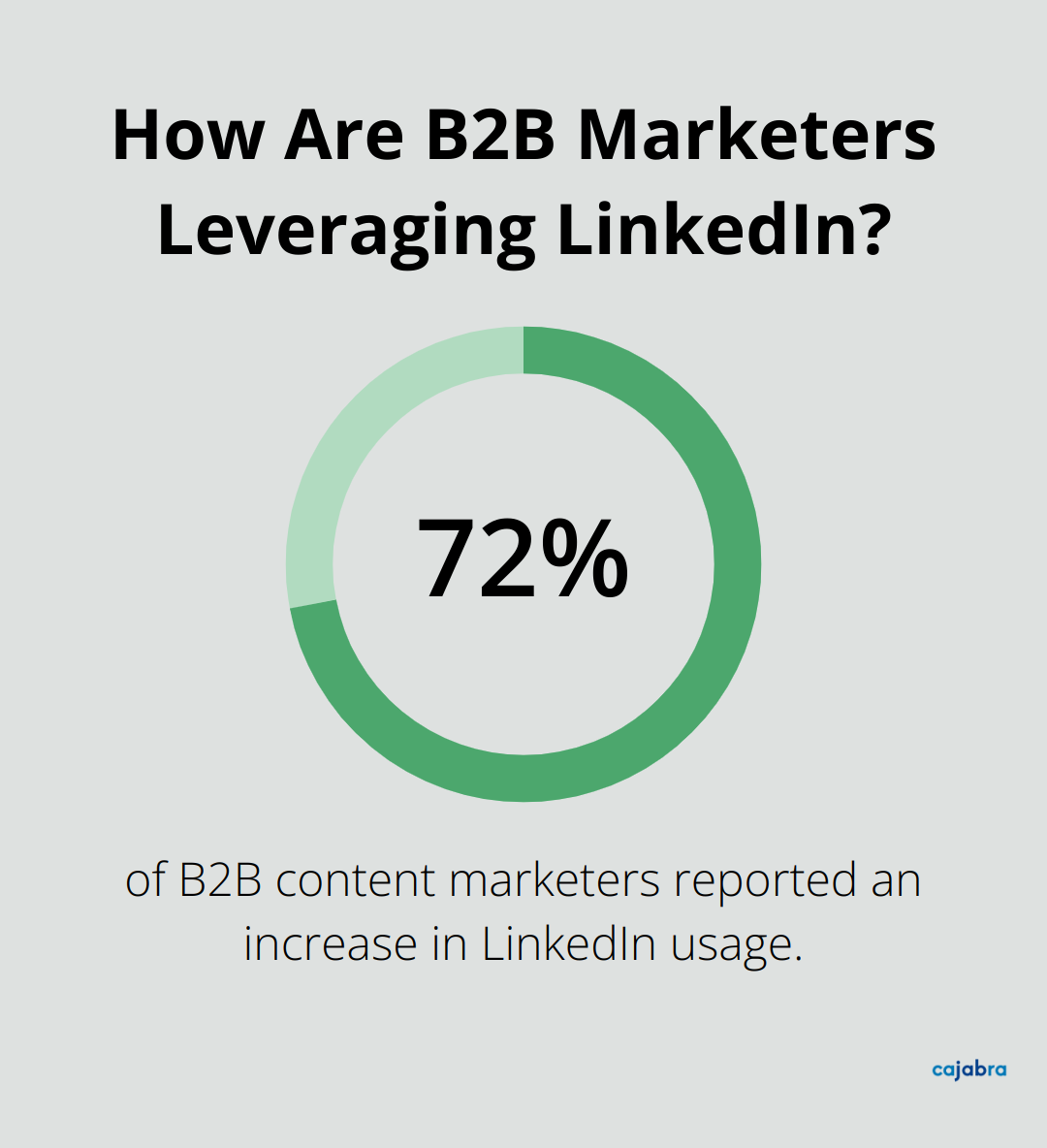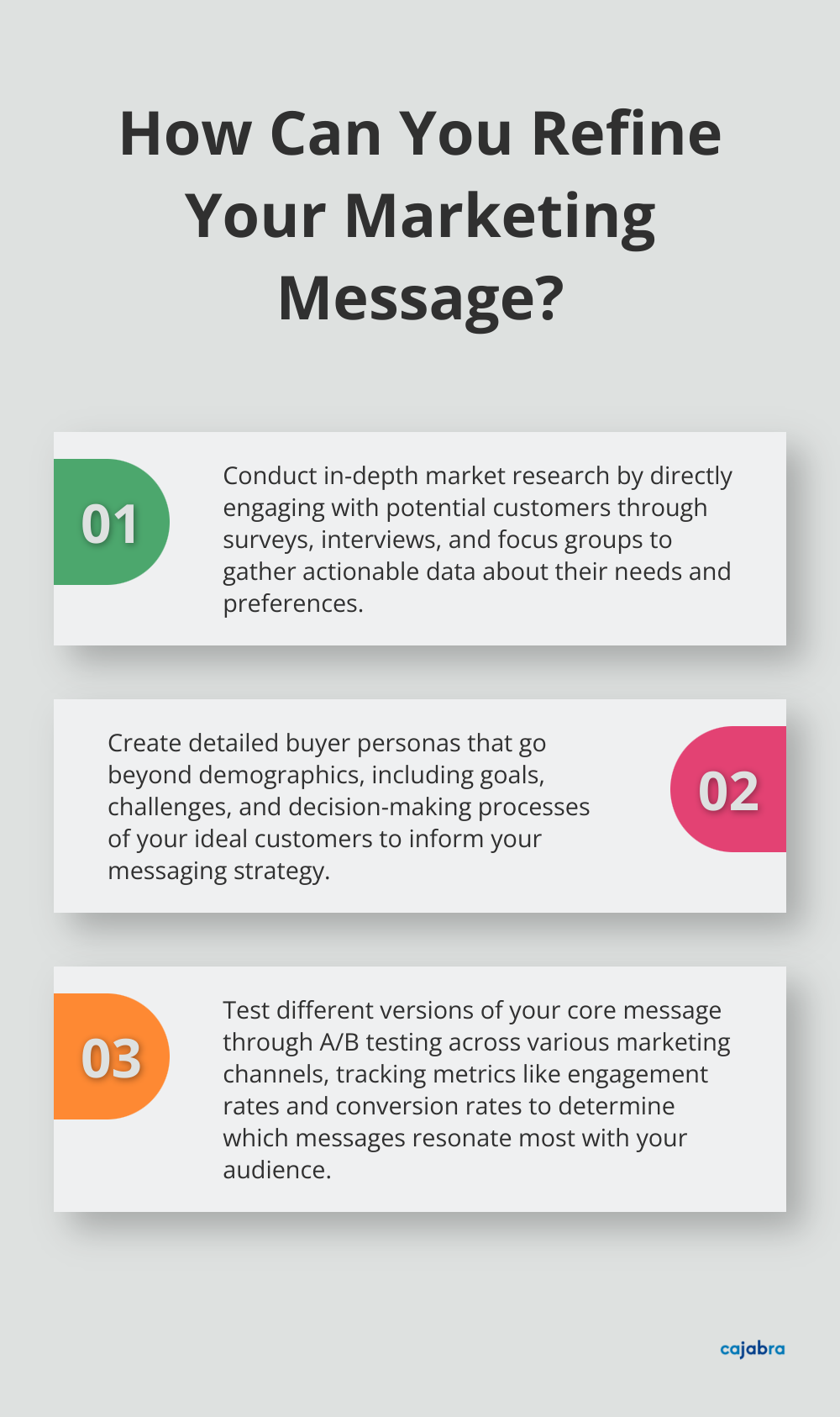
At Cajabra, LLC, we know that a strong product messaging strategy can make or break your marketing efforts.
It's the key to connecting with your audience, highlighting your unique value, and driving sales. In this post, we'll guide you through the process of creating a powerful product messaging strategy that resonates with your target market.
Get ready to transform how you communicate your product's value to potential customers.
To create a powerful product messaging strategy, you must first understand your target audience. Start with comprehensive market research. This involves more than just reading industry reports. Engage directly with potential customers through surveys, interviews, and focus groups. This approach yields real, actionable data. For example, a recent study revealed that 78% of consumers will do business with a company again after a mistake if the company's customer service is excellent.
After gathering research, develop buyer personas. These are not mere demographic profiles; they represent detailed portraits of your ideal customers. Include their goals, challenges, and decision-making processes. In the accounting sector, for instance, many target customers are small business owners (aged 35-50) who prioritize time-saving solutions and personalized financial advice.
Effective product messaging addresses specific customer pain points. Analyze your research to pinpoint these issues. In the accounting field, a major pain point is the absence of proactive financial planning from accountants. This insight allows for tailored messaging that highlights how accounting firms can provide forward-thinking financial advice.
Not all customers are the same. Segment your audience based on shared characteristics (e.g., industry, company size, or specific needs). This segmentation allows for more targeted and relevant messaging. For example, a mid-sized manufacturing company will have different accounting needs than a small retail business.
Customer needs and market conditions evolve. Regularly update your audience understanding to keep your messaging relevant and impactful. Set up systems to track industry trends, customer feedback, and market shifts. This ongoing process ensures your product messaging remains aligned with your audience's current needs and preferences.

As you develop a deep understanding of your target audience, you'll be well-positioned to craft a core message that resonates powerfully with potential customers. Let's explore how to define your unique value proposition and develop a compelling brand story in the next section.
Your unique value proposition (UVP) forms the foundation of your core message. It distinguishes you from competitors and explains the benefits of your product, how it solves customers' problems, and why it is different from others. Analyze your product's strengths and how they address your audience's pain points to define your UVP.

For accounting firms, a strong UVP might emphasize time-saving services and personalized financial guidance. For instance, a UVP could promise to transform accountants from overlooked to overbooked in 90 days by securing retainer-based clients. This clear, benefit-driven statement immediately communicates value to potential clients.
Your brand story creates an emotional connection with your audience. Identify your company's mission and values, then craft a narrative that aligns your product or service with these principles and shows how you help customers achieve their goals.
If your accounting firm values innovation and personalized service, your brand story might highlight how you use cutting-edge AI technology to provide tailored financial advice. This approach showcases your capabilities and demonstrates your commitment to client success.
While your UVP and brand story provide the emotional hook, you must also clearly communicate your product's tangible features and benefits. List all your product's features, then translate each feature into a benefit that directly addresses your audience's needs or solves their problems.
For example, if your accounting software includes automated reporting features, the benefit might read: "Save time on financial reporting, allowing you to focus on strategic business decisions." This approach clearly demonstrates how your product's features translate into real-world value for your customers.
Your core message should evolve as customers move through different stages of their journey. At the awareness stage, focus on addressing pain points and introducing your UVP. As potential customers move closer to a decision, provide more detailed information about features and benefits.
Once you've crafted your core message, test its effectiveness. Conduct A/B testing on different versions of your message across various marketing channels. Pay attention to metrics like engagement rates, click-through rates, and conversion rates to gauge which messages resonate most with your audience.
Regularly revisit and refine your message based on customer feedback and market changes. This ensures your messaging strategy remains relevant and impactful in a dynamic business environment.
Now that you've crafted a compelling core message, it's time to put it into action. The next chapter will explore how to implement your messaging strategy effectively across different channels and touchpoints.
The first step in implementing your messaging strategy is to choose the most effective channels to reach your target audience. For accounting firms, this might include professional networking sites like LinkedIn, industry-specific forums, and email marketing campaigns. A recent study found that 72% of B2B content marketers reported an increase in LinkedIn usage, making it a prime channel for reaching decision-makers in the accounting industry.

Don't limit yourself to digital channels. Traditional methods like speaking at industry conferences or publishing articles in trade publications can also effectively reach potential clients in the accounting sector.
Your messaging should evolve as potential clients move through different stages of their decision-making process. In the awareness stage, address pain points and introduce your unique value proposition. You might highlight how outsourced accounting services can save time and costs while ensuring accuracy for small business owners.
As prospects enter the consideration stage, provide more detailed information about your services and their benefits. Case studies and client testimonials can be particularly effective at this stage. You could share how your firm helped a manufacturing company reduce their tax liability by 15% through strategic financial planning.
In the decision stage, emphasize what sets you apart from competitors. This could include your specialized expertise, unique methodologies, or exceptional customer service. If you use the JAB System™ from Cajabra, highlight how it can help accountants secure retainer-based clients in just 90 days.
Implementing your messaging strategy requires ongoing testing and refinement to maximize its impact. Use A/B testing to compare different versions of your message across various channels. Pay attention to metrics like engagement rates, click-through rates, and conversion rates to gauge which messages resonate most with your audience.
You might test two different email subject lines for a campaign promoting your business advisory services. The version that generates a higher open rate can then be used for future campaigns.
Don't forget to gather qualitative feedback as well. Conduct surveys or interviews with clients to understand how your messaging influenced their decision to work with you. This insight can be invaluable for refining your approach over time.
While tailoring your message for different stages and channels is important, overall consistency is key. Ensure that your core value proposition and brand voice remain consistent whether a potential client encounters your message on your website, in a LinkedIn post, or during a face-to-face meeting.
This consistency helps build trust and reinforces your brand identity.
Try to use marketing automation tools to streamline your messaging implementation. These tools can help you schedule content, personalize messages, and track performance across multiple channels. For example, you could use a customer relationship management (CRM) system to tailor your messaging based on a prospect's interaction history with your firm.
Additionally, consider using AI-powered tools for content creation and optimization. These can help you generate ideas for messaging variations and predict which versions are likely to perform best with your target audience.
A powerful product messaging strategy sets businesses apart in today's competitive market. Companies must understand their target audience, craft compelling core messages, and implement strategies effectively to enhance marketing efforts and drive growth. Continuous evaluation and adaptation ensure the strategy remains effective in a dynamic business environment.

We at Cajabra specialize in helping accounting firms develop and implement impactful product messaging strategies. Our JAB System™ transforms accountants from overlooked to overbooked in 90 days by securing retainer-based clients. We offer tailored solutions to help you communicate your value effectively to potential clients.
Take the first step towards a more effective product messaging strategy today. We have the tools and expertise to help you succeed, whether you want to modernize your online presence or maximize revenue from existing clients. Visit our website to learn more about how we can help transform your accounting firm's marketing approach.



